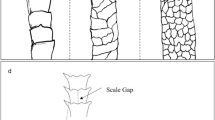Abstract
IT HAS been observed that sheep which graze in certain regions of the Iberian Peninsula, for example, along the Iberian Cordillera and especially in the Maella zone1,2 to which this work refers, lose their wool progressively (Fig. 1). Histological analysis shows that the folicular bundles separated by loose, very thin and elastic, connective tissue, assume at the beginning a slightly polygonal arrangement. As the alteration advances, they assume first a roundish shape and later an elongated one, until the follicles become completely independent (Fig. 2).
This is a preview of subscription content, access via your institution
Access options
Subscribe to this journal
Receive 51 print issues and online access
$199.00 per year
only $3.90 per issue
Buy this article
- Purchase on Springer Link
- Instant access to full article PDF
Prices may be subject to local taxes which are calculated during checkout
Similar content being viewed by others
References
Lopez, B., Pub. Junta Fomento Pecuario Zaragoza, No. 3, (1941).
Gil, F., Pub. Ministerio de Agricultura, 1946.
Gonzalez, G., and Garcia, J., Annales Nutrition et de l' Alimentation, No. 3-4 (1957).
Pacios, B., Thesis in course of publication. (private communication).
Fernandez, E., Thesis in preparation.
Author information
Authors and Affiliations
Rights and permissions
About this article
Cite this article
GONZALEZ, G., GARCIA, J. & FERNANDEZ, E. A Lesion of the Follicle and of the Fibre of Wool and its Possible Relation with an Excess of Iron in the Forage. Nature 184, 559–561 (1959). https://doi.org/10.1038/184559b0
Issue Date:
DOI: https://doi.org/10.1038/184559b0
Comments
By submitting a comment you agree to abide by our Terms and Community Guidelines. If you find something abusive or that does not comply with our terms or guidelines please flag it as inappropriate.



